Type 2 Diabetes Diet Guide
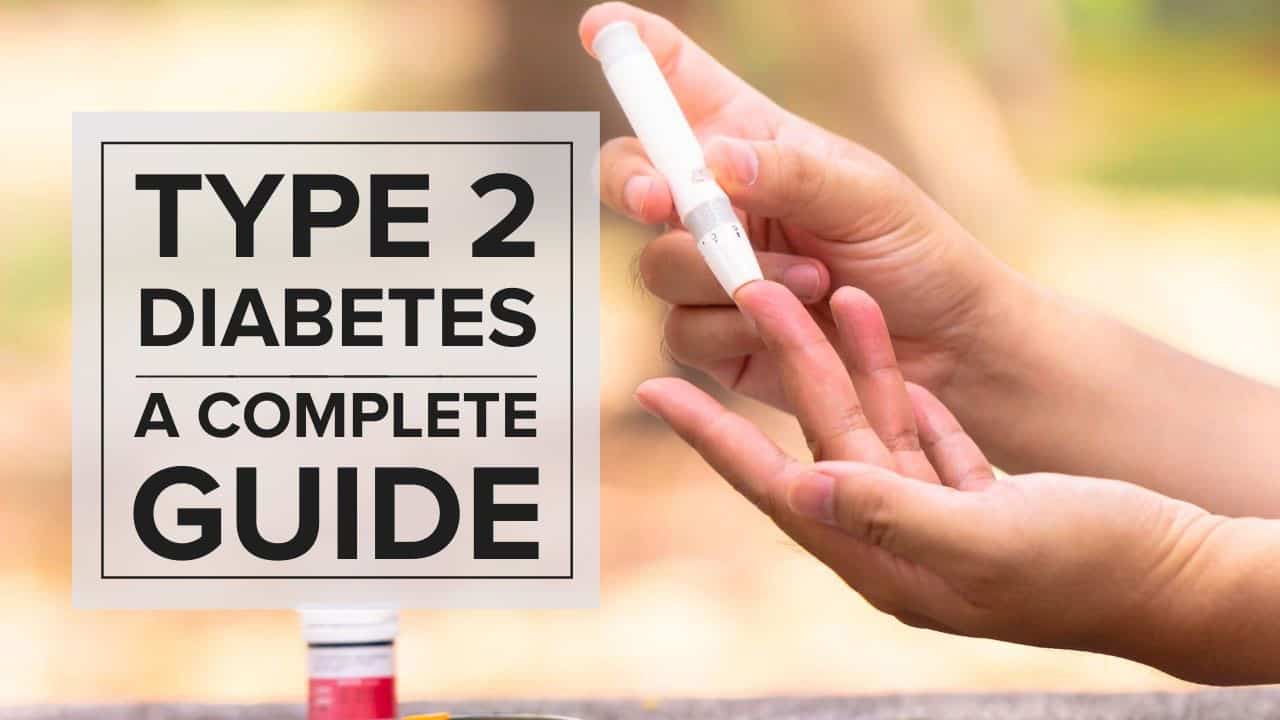
What is Type 2 Diabetes?
Type 2 diabetes mellitus, is a chronic condition characterized by high blood glucose (hyperglycemia) and a wide range of ensuing side effects.
Type 2 diabetes, sometimes referred to as adult-onset diabetes, affects more than 31 million people in the U.S. alone, and is one of the fastest-growing chronic conditions in the world today.
Type 2 diabetes specifically manifests as a result of a condition called insulin resistance, which is caused by the accumulation of excess fat in cells that are not designed to store large quantities of fat.
In its early stages, type 2 diabetes is referred to as "non-insulin-dependent," which is characterized by the following sequence of events:
- Step 1: Insulin resistance in your muscle and liver dramatically increase your insulin requirements
- Step 2: Insulin resistance in your muscle and liver increases over time, resulting in an increased demand for insulin production
- Step 3: The beta cells in your pancreas increase their insulin output, resulting in hyperinsulinemia
- Step 4: When beta cells can't make enough insulin to overcome insulin resistance in your muscle and liver, your blood glucose becomes elevated, causing hyperglycemia
In later stages, type 2 diabetes can become classified as "insulin-dependent," resulting in the following events:
- Step 5: Beta cells in your pancreas manufacture and secrete excess insulin for months or years, in an effort to overcome insulin resistance in your muscle and liver
- Step 6: Beta cells eventually lose their ability to overproduce insulin, and begin a process of programmed cell death called apoptosis
- Step 7: As beta cells begin to die, insulin production decreases
- Step 8: Beta cell exhaustion results in insufficient insulin production, which then leads to high blood glucose values
- Step 9: Exogenous insulin is required to properly control your blood glucose and minimize the risk for diabetes complications
Fortunately, type 2 diabetes is reversible in the majority of cases via strategic diet and lifestyle changes that increase insulin sensitivity.
In this article, we'll touch on the difference between type 1 and type 2 diabetes, as well as the specific symptoms to identify type 2 diabetes.
We'll also explore the causes and risk factors of type 2 diabetes, as well as what you can do to prevent, treat, and reverse type 2 diabetes completely.
Type 1 vs Type 2 Diabetes: What's The Difference?
In type 1 diabetes, insulin deficiency initially occurs as a result of an autoimmune condition in which your immune system mistakenly attacks the beta cells in your pancreas.
As a result, the population of beta cells in your pancreas is significantly compromised, resulting in insulin insufficiency and high blood glucose.
In non-insulin-dependent type 2 diabetes, the beta cells in your pancreas can produce enough insulin, but the insulin they produce is not powerful enough to overcome the amount of insulin resistance in your muscle and liver.
In the case of insulin-dependent type 2 diabetes, beta cells that have been overproducing insulin for months to years begin dying, resulting in a reduced population and insufficient insulin production.
Symptoms of Type 2 Diabetes
The core problem that all forms of diabetes have in common is hyperglycemia (high blood glucose), which can have a wide variety of side effects.
As a result, type 2 diabetes symptoms can include:
- Thirst
- Urination
- Unexplained weight loss
- Genital itching
- Stomatitis
- Visual disturbances
- Fatigue
- Confusion
- Slow-healing sores
- Frequent infections
- Areas of darkened skin, usually in the armpits and neck
It's important to note that these symptoms overlap with many other forms of diabetes, including type 1 diabetes, prediabetes, gestational diabetes, and type 1.5 diabetes.
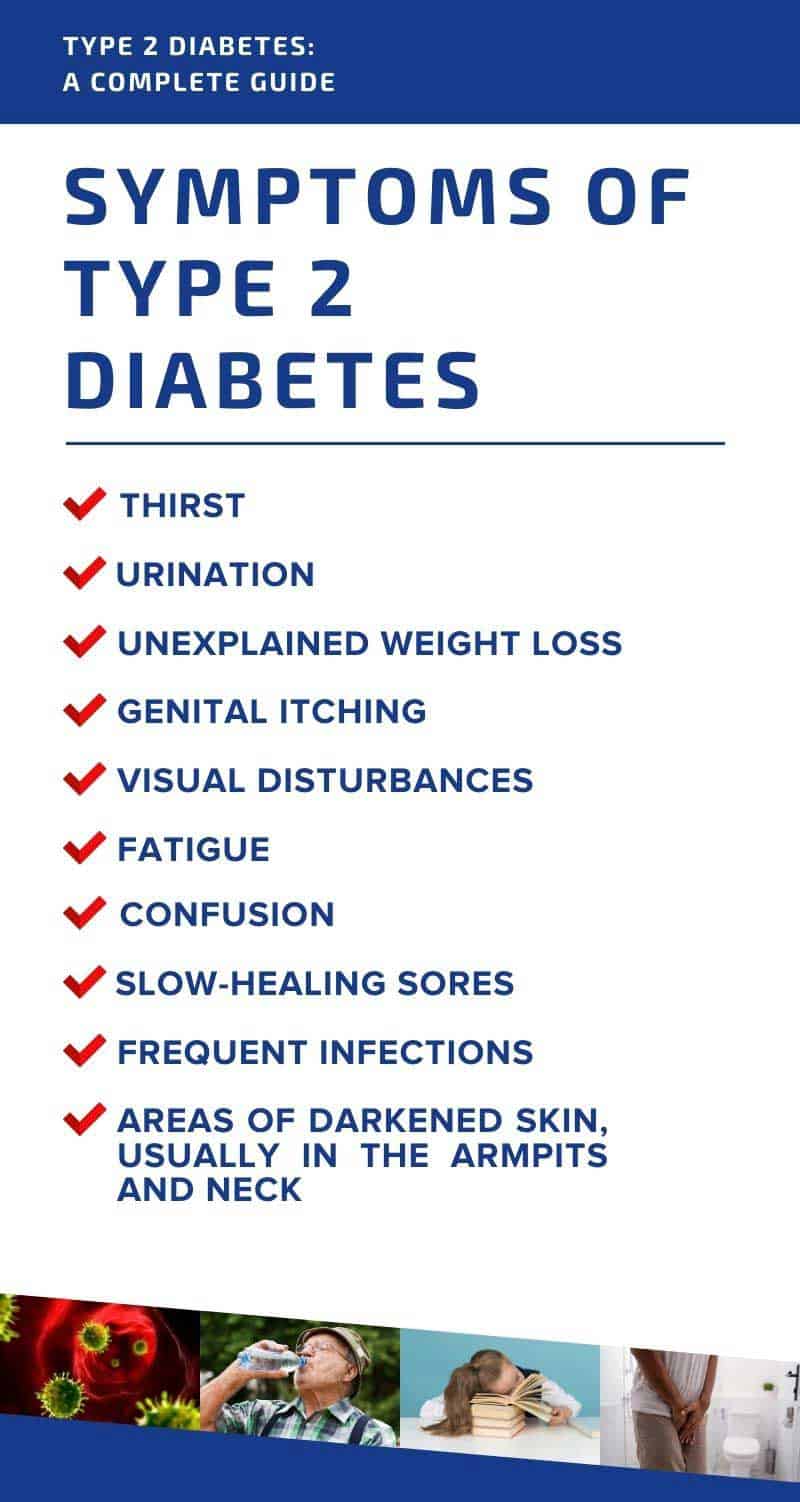
What Causes Type 2 Diabetes?
Type 2 diabetes is caused by insulin resistance. Left untreated, insulin resistance progresses to prediabetes, and then eventually to type 2 diabetes.
One common misconception is that high blood pressure and a high body weight are causes of type 2 diabetes. However, this is not technically true.
The same diet and lifestyle issues that can cause type 2 diabetes can also contribute to high blood pressure and weight gain, but they are not always a direct cause.
Instead, high blood pressure and weight gain are considered comorbidities of type 2 diabetes.

Type 2 Diabetes Risk Factors: What To Look For
There are both controllable risk factors (factors that you can change) and uncontrollable risk factors (factors you cannot change) for type 2 diabetes.
Fortunately, the vast majority of type 2 diabetes risk factors are within your control, including:
- Your total calorie intake
- The quantity of fat in your diet (especially saturated fat)
- The amount of packaged and processed foods you eat
- Your level of physical activity
- Your body weight
- Your alcohol consumption
- Your stress levels
- The presence of prediabetes
- The presence of gestational diabetes
The good news for you is that there is only one major factor of increased risk for type 2 diabetes that is technically out of your control:
- Your family history
However, despite the fact that certain genetics may leave you with a higher risk for type 2 diabetes, this condition is still extremely treatable and preventable through your diet and lifestyle in the majority of all cases.
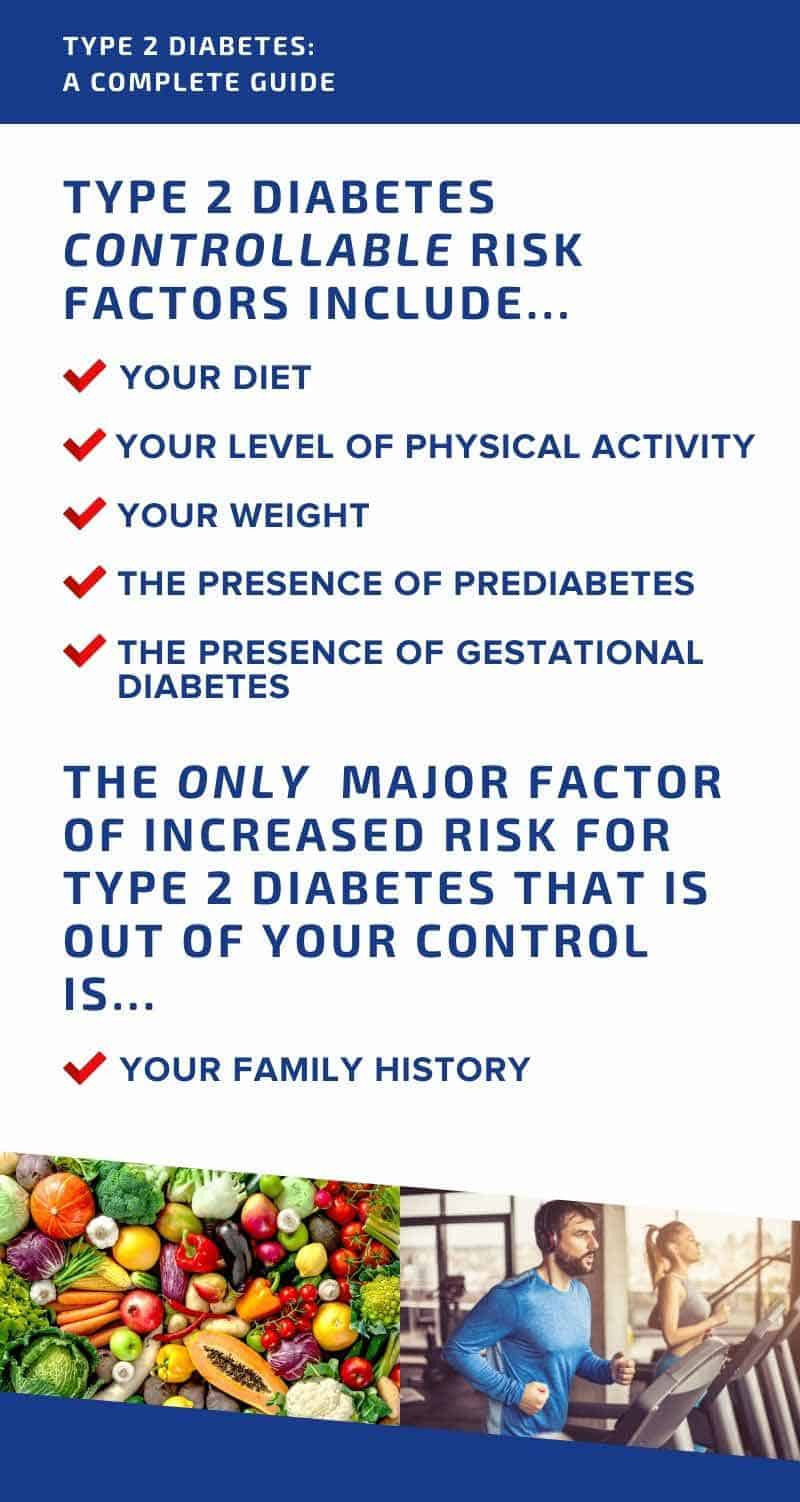

Complications of Type 2 Diabetes
If left unmanaged, type 2 diabetes drastically increases your risk for other diseases, with one report finding that people with type 2 diabetes spent up to 3 times more on medical complications.
In addition, type 2 diabetes can cause a number of direct and indirect health problems. Direct complications from diabetes include:
- Heart disease
- Kidney disease
- Kidney failure
- Nerve damage
- Failure or restriction of blood vessels
- Retinopathy
The underlying problem of insulin resistance in type 2 diabetes can also lead to indirect complications in your arteries, liver and muscles, kidneys, and ovaries, along with various neurological and brain disorders.
These diabetes complications include, but aren't limited to:
- Coronary artery disease
- Atherosclerosis
- Cancer
- High cholesterol
- High blood pressure
- Obesity
- Polycystic ovary syndrome (PCOS)
- Peripheral neuropathy
- Alzheimer's disease
- Chronic kidney disease
- Fatty liver disease
- And various other chronic conditions
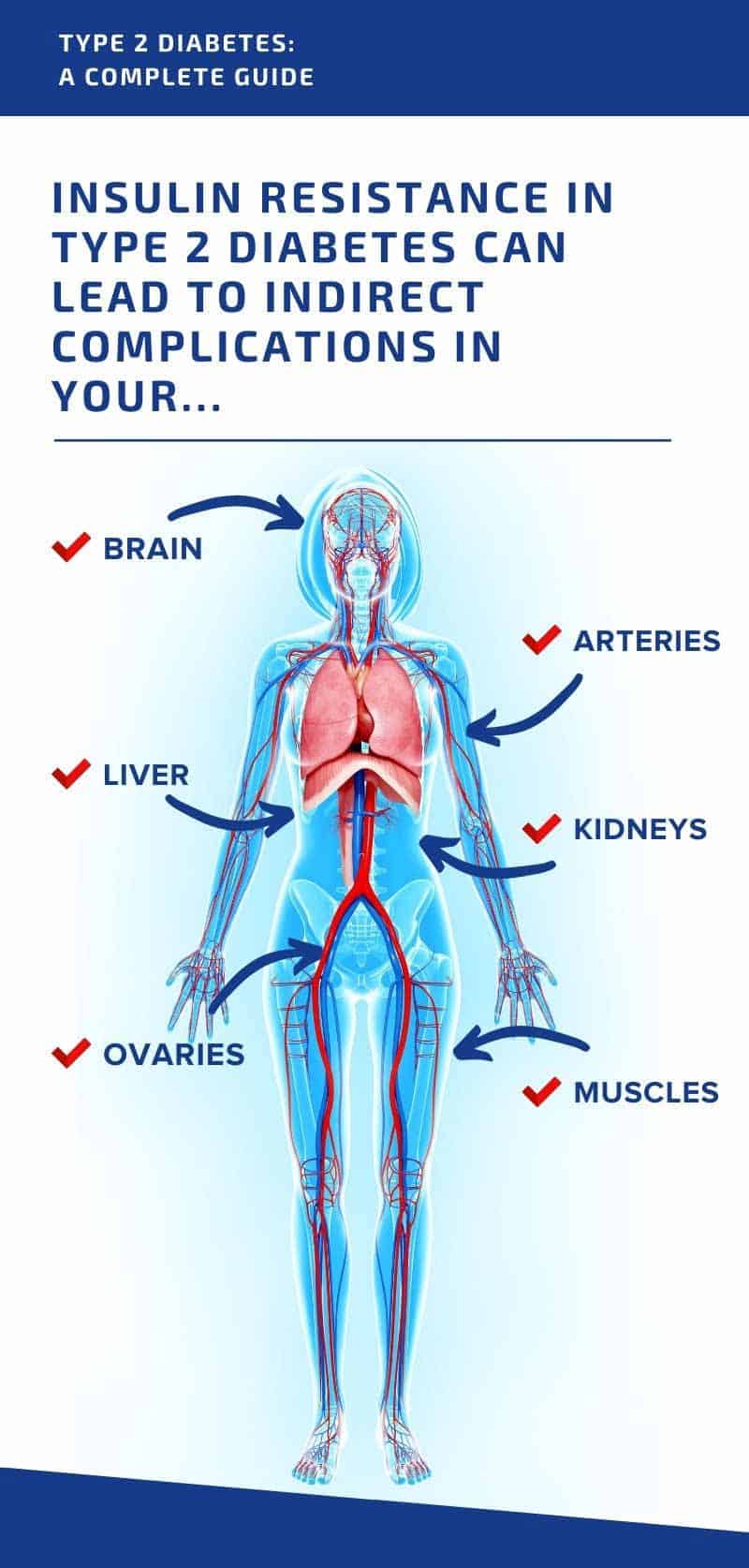
Diagnosing Type 2 Diabetes
According to the American Diabetes Association, in order to be diagnosed with type 2 diabetes, one of the following must be true:
- An A1c value ≥ 6.5%
- A fasting plasma glucose value ≥ 126 mg/dl (7.0 mmol/l). Fasting is defined as no caloric intake for at least 8 hours.
- A 2-hour plasma glucose value ≥ 200 mg/dl (11.1 mmol/l) during an oral glucose tolerance test (OGTT)
- A random plasma glucose value ≥ 200 mg/dl (11.1 mmol/l)
The majority of people live with some form of insulin resistance without recognizing the symptoms for years before being officially diagnosed with type 2 diabetes.
The A1c test is a blood test that provides information about your average blood glucose levels over the past 3 months.
An OGTT is a test of your ability to metabolize glucose in response to a glucose "challenge," and works like this:
- Step 1: After an extended fasting period (usually 24 hours), you'll arrive at a medical clinic. A doctor will test your fasting blood glucose (and sometimes fasting insulin)
- Step 2: You'll be asked to drink a glucose solution containing 75g of glucose
- Step 3: Depending on the clinic and the specific testing protocol, a medical professional will test your blood glucose (and sometimes insulin), either following 1 hour, 2 hours, and/or 3 hours
- Step 4: If your blood glucose is greater than 200 mg/dL (11.1 mmoL) 2 hours after you drink the glucose solution, you are diagnosed with type 2 diabetes
Identifying Type 2 vs Type 1 Diabetes
Type 2 diabetes is a vastly more common form of diabetes, especially when diagnosed in adults.
However, there are cases of adult-onset autoimmune diabetes, also called latent autoimmune diabetes in adults (LADA). This distinction can be found through c-peptide testing.
Fortunately, the Mastering Diabetes Method can treat type 1 diabetes, as well as prevent and reverse type 2 diabetes.
Prevention
There are three major areas that can drastically reduce your risk of developing type 2 diabetes:
- The calorie count and proportion of fat calories in your diet
- Your eating schedule/timing of meals
- Daily movement and exercise
These lifestyle changes — adjusting to a more healthy diet, adding more physical activity, and integrating intermittent fasting — are the key to both preventing and reversing type 2 diabetes.
Is Type 2 Diabetes Curable?
Yes, type 2 diabetes is curable.
The key to reversing type 2 diabetes is in reversing insulin resistance through strategic changes to your diet and activity levels.
If you are able to do that, you are able to effectively reverse type 2 diabetes (in the majority of cases).
Simply managing the symptoms of diabetes using oral medications or insulin does not reverse type 2 diabetes.
Pharmacological treatment does not dramatically increase your level of insulin sensitivity, which is required to completely reverse type 2 diabetes.
Below, we'll touch on the three major areas that can help you reverse type 2 diabetes permanently.
How To Manage Type 2 Diabetes
The same dietary and lifestyle strategies that can help you prevent type 2 diabetes can also help you manage and reverse insulin resistance, return to normal blood glucose levels, and reverse type 2 diabetes.
These strategies are:
- Eating a low-fat, plant-based, whole-food diet specifically designed to reverse insulin resistance permanently
- Integrating intermittent fasting into your dietary schedule
- Adding daily movement to your routine
We'll go into each of these areas in detail below.
Managing Type 2 Diabetes Through Diet
The most effective way to manage and reverse type 2 diabetes involves your diet.
Specifically, the research points to a low-fat, plant-based, whole-food diet that's high in whole carbohydrates.
This way of eating results in dramatically increased insulin sensitivity, which in turn results in:
- Better blood glucose control
- A 10-60% reduction in insulin use
- Reduced oral medication use (by 52% on average)
- Increasing your time in range (TIR)
- A 2.0% reduction in A1c
- Reduced LDL cholesterol
- Reduced blood pressure
- Increased energy levels
- Reduced risk for many chronic diseases
Compared to the Standard American Diet, these new guidelines can be quite a shift. Here are some helpful guidelines.
Red Light, Green Light, Yellow Light Foods
The guidelines for reversing type 2 diabetes are actually very simple, following a clear "green light, yellow light, red light," categorization for foods.
"Green light" foods include all fruits (except avocado, durian, and dates), starchy and non-starchy vegetables, all legumes (except soybeans), intact whole grains (minimally processed), and herbs and spices.
Green light foods are foods that you can eat as much as you want, as these are unrefined whole foods low in fat with a high nutrient density that have been demonstrated to reverse insulin resistance.
"Yellow light" foods include whole grain or bean pastas, whole grain cereals, refined grains, whole grain bread and tortillas, avocados, nuts, seeds, coconut meat, soybeans, and soy products.
Yellow light foods are foods okay to include in small quantities, because they are slightly processed or have higher fat content. They shouldn't be daily staples, but are still considered a "healthy" choice.
"Red light" foods include all red meats, all white meats, all seafood, eggs, dairy products, refined oils, and refined sugars (simple carbohydrates).
Red light foods are foods that we recommend removing from your cabinet, your fridge, and your plate.
These foods are documented by evidence-based research to cause insulin resistance, increase your blood glucose (fasting and post-meal), and promote chronic diseases in individuals with type 2 diabetes.
If you'd like to learn more about the low-fat, plant-based, whole-food diet, and how you can use it to reverse insulin resistance, you can check our comprehensive guide to reversing insulin resistance with your diet.
You can also read this article on high-carbohydrate foods proven to reverse insulin resistance for more details of exactly what to eat.
Managing Type 2 Diabetes Through Intermittent Fasting
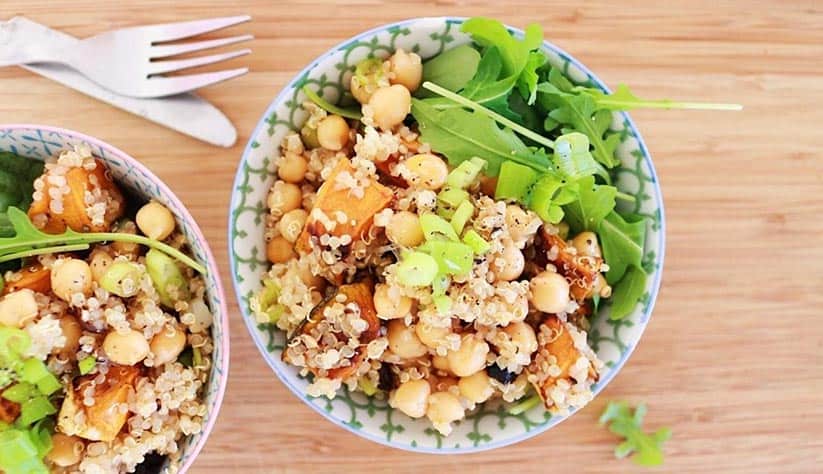
Another powerful strategy to reverse type 2 diabetes involves intermittent fasting.
Intermittent fasting is a dietary strategy where periods of food consumption ('eating windows') alternate with fasting periods ('fasting windows').
How it Works
The key to intermittent fasting is a process called autophagy, which is left over biological adaptation from when humans would need sustain themselves over extended periods without food.
While you're fasting, cells in tissues throughout your body still need ATP, the cellular form of energy. However, during a fast, those same cells have little-to-no access to nutrients from food.
Rather than shut down, your cells generate ATP by oxidizing:
- Stored glucose from glycogen
- Fat from triglyceride
- Amino acids from protein
In essence, your body recycles old cells, proteins, and fats, which is actually very beneficial to your body when done in short and controlled periods.
Combined with a low-fat, plant-based, whole-food diet, intermittent fasting becomes an incredibly powerful tool for reversing type 2 diabetes.
Making it Happen
There are multiple methods of intermittent fasting -- the 16:8 method, the 24-hour method, the 5:2 method – and all are designed to allow for intentional, long periods between meals, specifically designed to improve many aspects of your overall health.
If you'd like to learn more about this process, you can check out our comprehensive guide to intermittent fasting.
Managing Type 2 Diabetes Through Exercise
Exercise is the third incredibly powerful strategy for reversing insulin resistance in type 2 diabetes.
When you exercise, cells in your muscle increase their energy requirements, which in turn increases their glucose requirements.
When your cells increase their energy demands, excess triglyceride is burned inside muscle cells, which in turn increases their responsiveness to insulin.
How It Works
At its most basic level, increasing your daily level of physical activity places a strain on your muscle tissue, which then signals muscle cells to manufacture more mitochondria.
Even assuming your diet has not changed at all, this higher mitochondrial density draws on your excess fat reserves, which in turn increases insulin action.
Because daily movement is such a powerful insulin sensitizer, we can all but guarantee that increased exercise can do the following:
- Reduce your need for oral medication and insulin
- Reduce your fasting and post-meal blood glucose
- Reduce your total cholesterol
- Reduce your LDL cholesterol
- Increase your HDL cholesterol
- Improve the condition of blood vessels in tissues all over your body.
Making it Happen
For some advice on adding exercise to your routine and keeping it there, you can check out our article on the topic, as well as our NY Times Bestselling Book on the Mastering Diabetes Method.
For some advice on adding exercise to your routine and keeping it there, you can check out our article on the topic, as well as our NY Times Bestselling Book on the Mastering Diabetes Method.
Managing Type 2 Diabetes Using Medication
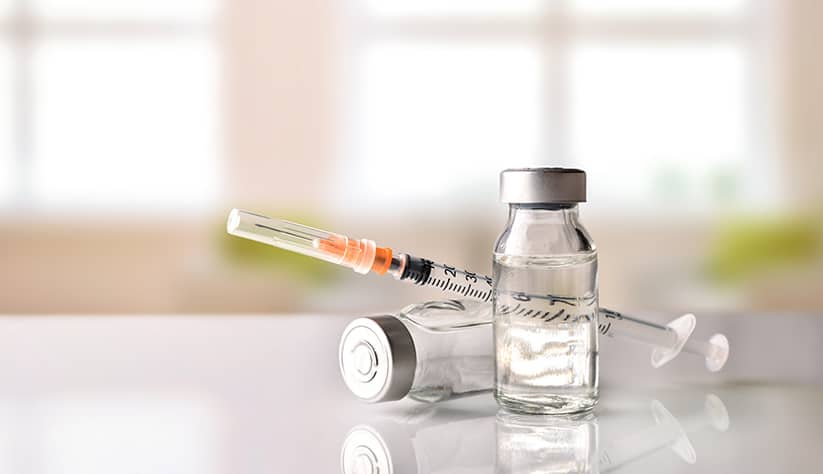
In addition to diet and lifestyle changes, type 2 diabetes can also require two more acute interventions: oral medications and insulin.
Diabetes Medications
Treatment for type 2 diabetes often centers around diabetes medications, which are prescribed to lower your blood glucose, independent of diet and exercise.
These oral medications fall into a few overarching categories:
- Insulin stimulants, which incite your body to produce more insulin, like sulfonylureas and meglitinides.
- Digestive stimulants, which activate or prolong hormones within your digestive system to better process blood glucose, like GLP-1 receptor agonists or DPP-4 inhibitors.
- Glucose inhibitors, which reduce your body's ability to absorb glucose, like SGLT-2 inhibitors, alpha-glucosidase inhibitors, and biguanides (the most common of which is metformin).
- Fat redistributors, which redirect stored fat to "where it's supposed to be," like thiazolidinediones.
Insulin Injections
Since type 2 diabetes is caused by insulin resistance, insulin injections merely supplement your body's endogenous insulin production, helping to lower your blood glucose.
Insulin injections fall into two main categories:
- Basal insulin, which is also called background insulin or long-acting insulin
- Bolus insulin, which is also called rapid-acting or short-acting insulin
Transitioning Away from Medications
Remember, treating the symptoms of type 2 diabetes with medication will not treat the underlying causes.
The only way to effectively reverse type 2 diabetes is to reverse the underlying insulin resistance, which will reduce, and ultimately reduce your biological need for medication.
Pharmaceutical medications can have many benefits. They may help to control your blood glucose, improve insulin secretion, reduce your blood pressure, reduce your cholesterol, and reduce pain in the short term.
But the intensive treatment of blood glucose with medications can have an extensive list of side effects, and a number of negative long-term effects, which include increased risk for heart failure, liver failure, kidney failure, stroke, and even death.
That's why we recommend a dedicated, concerted effort through lifestyle and dietary changes. These changes are safe, increase your energy and overall health, and are a sustainable long-term solution.
Mastering Type 2 Diabetes | Get Support
The most important takeaway from this article is that type 2 diabetes can be entirely controlled or reversed by changes to your diet and lifestyle.
That's right. You have the power and the ability to reverse type 2 diabetes.
However, in most cases, these diet and lifestyle changes can be significant shifts to your habits and routine, which can often seem daunting.
To help you make the transition, we have a comprehensive Mastering Diabetes Coaching Program, with expert diabetes educators who can help you every step along the way.
Or, if you prefer to change your lifestyle by yourself, then you can join the Do-It-Yourself Program, which has changed the lives of more than 2,500 people around the world.
Resources, recipes, guides, a vibrant community, small groups, one-on-one coaching — we have options to suit whatever your particular needs are.
Our goal at Mastering Diabetes is to help everyone with diabetes understand that they have the power to transform their lives, and to provide any help we can along the transition to managing and reversing this disease.
And always remember, the power is in YOUR hands!
Stop Guessing What to Eat
Get Delicious Recipes Sent to Your Inbox Every Week!
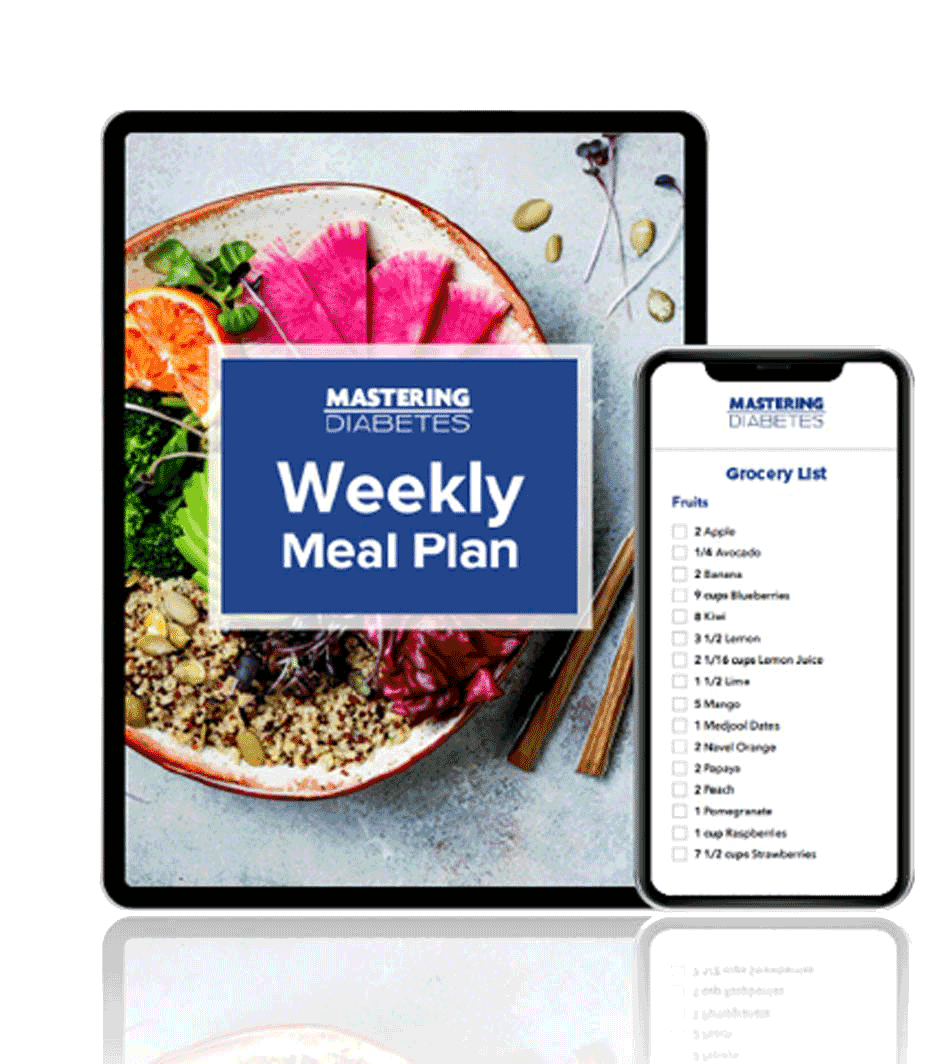
Discover the custom-designed Weekly Meal Plan that gives you clarity on what to eat and how to shop to simplify your journey to lower blood sugar, weight loss, and your best A1c
Other Articles You Might Like...
+ References
Mastering Diabetes has strict guidelines for scientific references in our articles. We rely on peer-reviewed studies, academic research institutions, governmental organizations, and reputable medical organizations. We do our best to avoid using non evidence-based references in all articles. The references in this article are listed below.
Healthline. "10 Evidence-Based Health Benefits of Intermittent Fasting," August 16, 2016. https://www.healthline.com/nutrition/10-health-benefits-of-intermittent-fasting.
"Autophagy: Definition, Diet, Fasting, Cancer, Benefits, and More." https://www.healthline.com/health/autophagy.
"Basal-Bolus Insulin Therapy: How to Use It, Benefits, and Risks," March 29, 2019. https://www.medicalnewstoday.com/articles/316616.
Beigrezaei, Sara, Reza Ghiasvand, Awat Feizi, and Bijan Iraj. "Relationship between Dietary Patterns and Incidence of Type 2 Diabetes." International Journal of Preventive Medicine 10 (July 5, 2019). https://doi.org/10.4103/ijpvm.IJPVM_206_17.
CDC. "Type 2 Diabetes." Centers for Disease Control and Prevention, May 30, 2019. https://www.cdc.gov/diabetes/basics/type2.html.
CDC. "CDC Press Releases," January 1, 2016. https://www.cdc.gov/media/releases/2017/p0718-diabetes-report.html.
"Complications | ADA." https://www.diabetes.org/diabetes/complications.
"Diabetes Overview | All Content | NIDDK." https://www.niddk.nih.gov/health-information/diabetes/overview/all-content.
"Diagnosis and Classification of Diabetes Mellitus." Diabetes Care 33, no. Suppl 1 (January 2010): S62–69. https://doi.org/10.2337/dc10-S062.
"DPP-4 Inhibitors (Gliptins) - Drugs, Suitability, Benefits & Side Effects." https://www.diabetes.co.uk/diabetes-medication/dpp-4-inhibitors.html.
Drivsholm, T., N. de Fine Olivarius, A. B. S. Nielsen, and V. Siersma. "Symptoms, Signs and Complications in Newly Diagnosed Type 2 Diabetic Patients, and Their Relationship to Glycaemia, Blood Pressure and Weight." Diabetologia 48, no. 2 (February 2005): 210–14. https://doi.org/10.1007/s00125-004-1625-y.
"Easy-to-Follow Guidelines to Reverse Insulin Resistance." https://www.masteringdiabetes.org/diabetes-nutrition-guidelines/.
"A Basal-Bolus Injection Regimen Involves Taking a Number of Injections through the Day." Diabetes (blog), January 15, 2019. https://www.diabetes.co.uk/insulin/basal-bolus.html.
"Biguanide Refers to a Group of Oral Type 2 Diabetes Drugs That Work by Preventing the Production of Glucose in the Liver and Improving Insulin Sensitivity." Diabetes (blog), January 15, 2019. https://www.diabetes.co.uk/diabetes-medication/biguanides.html.
"Thiazolidinediones, Also Known as Glitazones, Are a Group of Oral Anti-Diabetic Drugs Designed to Treat Patients with Type 2 Diabetes." Diabetes (blog), January 15, 2019. https://www.diabetes.co.uk/diabetes-medication/thiazolidinediones.html.
"Effect of Intensive Versus Standard Blood Glucose Control in Patients With Type 2 Diabetes Mellitus in Different Regions of the World: Systematic Review and Meta‐analysis of Randomized Controlled Trials | Journal of the American Heart Association." https://www.ahajournals.org/doi/10.1161/JAHA.114.001577.
"Effects of Intensive Glucose Lowering in Type 2 Diabetes." New England Journal of Medicine 358, no. 24 (June 12, 2008): 2545–59. https://doi.org/10.1056/NEJMoa0802743.
"Exercise: It's the Real Thing! | Nutrition Reviews | Oxford Academic." https://academic.oup.com/nutritionreviews/article/67/3/172/1890837.
"Exercise Training‐induced Improvements in Insulin Action - Hawley - 2008 - Acta Physiologica - Wiley Online Library." https://onlinelibrary.wiley.com/doi/abs/10.1111/j.1748-1716.2007.01783.x.
Galaviz, Karla I., K. M. Venkat Narayan, Felipe Lobelo, and Mary Beth Weber. "Lifestyle and the Prevention of Type 2 Diabetes: A Status Report." American Journal of Lifestyle Medicine 12, no. 1 (November 24, 2015): 4–20. https://doi.org/10.1177/1559827615619159.
"Glucagon-Like Peptide 1 Receptor Agonists for Type 2 Diabetes | Diabetes Spectrum." https://spectrum.diabetesjournals.org/content/30/3/202.
Goyal, Rajeev, and Ishwarlal Jialal. "Diabetes Mellitus Type 2." In StatPearls. Treasure Island (FL): StatPearls Publishing, 2020. http://www.ncbi.nlm.nih.gov/books/NBK513253/.
Group, The ACCORD Study. "Long-Term Effects of Intensive Glucose Lowering on Cardiovascular Outcomes." Research-article. http://dx.doi.org/10.1056/NEJMoa1006524. Massachusetts Medical Society, March 2, 2011. World. https://doi.org/10.1056/NEJMoa1006524.
Han, Ling, Lijin Ji, Jing Chang, Jian Wen, Wenting Zhao, Hongli Shi, Linuo Zhou, et al. "Peripheral Neuropathy Is Associated with Insulin Resistance Independent of Metabolic Syndrome." Diabetology & Metabolic Syndrome 7, no. 1 (March 3, 2015): 14. https://doi.org/10.1186/s13098-015-0010-y.
"High Carb Foods Proven to Reverse Insulin Resistance & Type 2 Diabetes." https://www.masteringdiabetes.org/high-carb-foods-reverse-insulin-resistance/.
Hinnen, Deborah. "Glucagon-Like Peptide 1 Receptor Agonists for Type 2 Diabetes." Diabetes Spectrum 30, no. 3 (August 1, 2017): 202–10. https://doi.org/10.2337/ds16-0026.
"How Intermittent Fasting Can Help You Lose Weight." https://www.healthline.com/nutrition/intermittent-fasting-and-weight-loss.
"How to Lose Body Fat Using Your Food and Fitness." https://www.masteringdiabetes.org/how-to-lose-body-fat-food-fitness/.
"Intermittent Fasting 101 — The Ultimate Beginner's Guide." https://www.healthline.com/nutrition/intermittent-fasting-guide#1.
"Intermittent Fasting Can Be Good for Heart Health - The Washington Post." https://www.washingtonpost.com/health/intermittent-fasting-works-for-many--not-only-for-weight-loss-but-also-for-heart-health/2020/06/12/11420c1c-a4d5-11ea-b619-3f9133bbb482_story.html.
Kirwan, John P., Thomas P. J. Solomon, Daniel M. Wojta, Myrlene A. Staten, and John O. Holloszy. "Effects of 7 Days of Exercise Training on Insulin Sensitivity and Responsiveness in Type 2 Diabetes Mellitus." American Journal of Physiology-Endocrinology and Metabolism 297, no. 1 (July 1, 2009): E151–56. https://doi.org/10.1152/ajpendo.00210.2009.
Korenblat, Kevin M., Elisa Fabbrini, B. Selma Mohammed, and Samuel Klein. "Liver, Muscle, and Adipose Tissue Insulin Action Is Directly Related to Intrahepatic Triglyceride Content in Obese Subjects." Gastroenterology 134, no. 5 (May 1, 2008): 1369–75. https://doi.org/10.1053/j.gastro.2008.01.075.
Lim, S. S., N. S. Kakoly, J. W. J. Tan, G. Fitzgerald, M. Bahri Khomami, A. E. Joham, S. D. Cooray, et al. "Metabolic Syndrome in Polycystic Ovary Syndrome: A Systematic Review, Meta-Analysis and Meta-Regression." Obesity Reviews 20, no. 2 (2019): 339–52. https://doi.org/10.1111/obr.12762.
Olokoba, Abdulfatai B., Olusegun A. Obateru, and Lateefat B. Olokoba. "Type 2 Diabetes Mellitus: A Review of Current Trends." Oman Medical Journal 27, no. 4 (July 2012): 269–73. https://doi.org/10.5001/omj.2012.68.
Phillips, Matthew C.L. "Fasting as a Therapy in Neurological Disease." Nutrients 11, no. 10 (October 17, 2019). https://doi.org/10.3390/nu11102501.
Ramachandran, A. "Know the Signs and Symptoms of Diabetes." The Indian Journal of Medical Research 140, no. 5 (November 2014): 579–81.
Reaven Gerald. "Insulin Resistance and Coronary Heart Disease in Nondiabetic Individuals." Arteriosclerosis, Thrombosis, and Vascular Biology 32, no. 8 (August 1, 2012): 1754–59. https://doi.org/10.1161/ATVBAHA.111.241885.
Research, Center for Drug Evaluation and. "Sodium-Glucose Cotransporter-2 (SGLT2) Inhibitors." FDA, December 28, 2018. https://www.fda.gov/drugs/postmarket-drug-safety-information-patients-and-providers/sodium-glucose-cotransporter-2-sglt2-inhibitors.
"Retrospective Evaluation of an Online Diabetes Health Coaching Program: A Pilot Study - Jordan Sarver, Cyrus Khambatta, Robby Barbaro, Bhakti Chavan, David Drozek, 2019." https://journals.sagepub.com/doi/10.1177/1559827619879106.
"Role of Insulin Resistance in Human Disease | Diabetes." https://diabetes.diabetesjournals.org/content/37/12/1595.
Sami, Waqas, Tahir Ansari, Nadeem Shafique Butt, and Mohd Rashid Ab Hamid. "Effect of Diet on Type 2 Diabetes Mellitus: A Review." International Journal of Health Sciences 11, no. 2 (2017): 65–71.
Schlienger, Jean-Louis. "[Type 2 diabetes complications]." Presse Medicale (Paris, France: 1983) 42, no. 5 (May 2013): 839–48. https://doi.org/10.1016/j.lpm.2013.02.313.
Sreekumar, Raghavakaimal, and K. Sreekumaran Nair. "Skeletal Muscle Mitochondrial Dysfunction & Diabetes." The Indian Journal of Medical Research 125, no. 3 (March 2007): 399–410.
"Study Discovers Novel Ways Intermittent Fasting Improves Liver Health." https://newatlas.com/health-wellbeing/intermittent-fasting-liver-metabolism-protein-health/.
"Sulfonylureas - Side Effects & Precautions | Everyday Health." https://www.everydayhealth.com/sulfonylureas/guide/.
Targher, Giovanni, and Christopher D. Byrne. "Non-Alcoholic Fatty Liver Disease: An Emerging Driving Force in Chronic Kidney Disease." Nature Reviews Nephrology 13, no. 5 (May 2017): 297–310. https://doi.org/10.1038/nrneph.2017.16.
National Institute of Diabetes and Digestive and Kidney Diseases. "The A1C Test & Diabetes | NIDDK." https://www.niddk.nih.gov/health-information/diagnostic-tests/a1c-test.
"The Association Between Diabetes and Dementia Among Elderly Individuals: A Nationwide Inpatient Sample Analysis - Dean Sherzai, Ayesha Sherzai, Keith Lui, Deyu Pan, Daniel Chiou, Mohsen Bazargan, Magda Shaheen, 2016." https://journals.sagepub.com/doi/10.1177/0891988715627016.
"The Benefits of Intermittent Fasting." https://www.ucihealth.org:443/blog/2020/01/intermittent-fasting/.
"The Insulin Resistance Diet Definitive Guide – What to Eat and Why." https://www.masteringdiabetes.org/reverse-insulin-resistance-presentation/.
Mayo Clinic. "Type 2 Diabetes - Symptoms and Causes." https://www.mayoclinic.org/diseases-conditions/type-2-diabetes/symptoms-causes/syc-20351193.
"What Are Meglitinides?" https://www.medscape.com/answers/117853-6504/what-are-meglitinides.
"What's the Difference Between Type 1 and Type 2 Diabetes?" https://www.healthline.com/health/difference-between-type-1-and-type-2-diabetes.
"α-Glucosidase Inhibitors for Patients With Type 2 Diabetes | Diabetes Care." https://care.diabetesjournals.org/content/28/1/154.
Leave a Comment Below
Source: https://www.masteringdiabetes.org/type2-diabetes/


0 Response to "Type 2 Diabetes Diet Guide"
Post a Comment